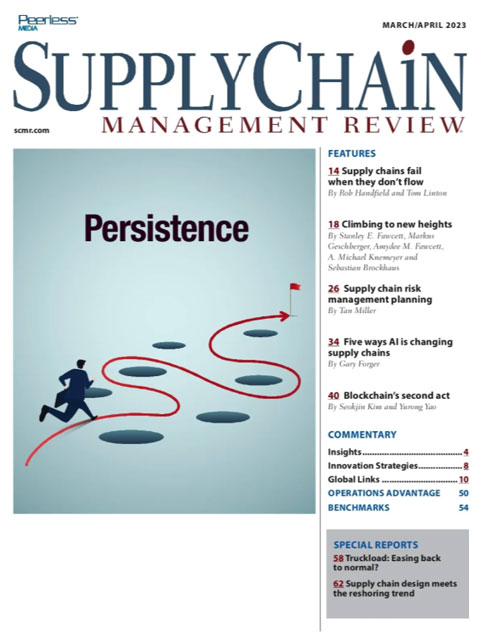Sorry, but your login has failed. Please recheck your login information and resubmit. If your subscription has expired, renew here.
March-April 2023
In June 2013, Frank Quinn stepped down as the only editorial director Supply Chain Management Review had ever known. “In thinking about those whom I’m indebted to for the success of SCMR over 16 years, there is one constituency that must rank first on the list—you, the reader,” Frank wrote, as he handed over the reins to Bob Trebilcock. Now, Bob has done the same, handing over the reins to the next generation. I am very proud to be that next generation. In a farewell letter of sorts, Bob wrote that he was the “old” and I as the “new.” Nothing could be further from the truth. There is no old or new, only continuity. That continuity is… Browse this issue archive.Need Help? Contact customer service 847-559-7581 More options
In the natural world, we are continuously aware of movement and flows. Snow falls onto mountains, melts in the spring and flows into the rivers, which flow into the ocean. Birds flow from northern hemispheres to southern climates, and then go back again. The tides flow back and forth with the moon, and gravity pulls objects to the center. We learn from natural flows about how things move. In the last several years, supply chains stopped moving. The reasons for this range from the COVID-19 pandemic’s direct impacts on production output in China, and material supply chain disruptions, labor shortages as well as unexpected demand surges. All of these have one common denominator: The flow or movement of materials is constrained by their physical design.
What are the barriers that prevent our global supply chains from flowing?
We need to unleash supply chains, not control them
Prior to the COVID-19 pandemic, parts and products flowed quickly and fluidly, navigating their way around barriers to reach their destinations. By applying principles from the physical world, we can reduce the friction that disrupts our supply chains since the onset of the COVID-19 pandemic. But doing so will require managers to rethink their concept of how global supply chains are governed and will necessitate bold investments in technology, tighter supplier relationships, and a change in traditional supply chain thinking.
The principles of flow are grounded in physics, which provide a number of simple and important laws that are irrefutable; these laws determine how fluids, electricity and matter travel. Physical flows are measured using metrics such as speed, distance, electrical flow and other dimensions. But these physical flows can also be used to assess the design and management of supply chains. Drawing from our recent book, we propose a set of five simple guidelines that can be applied to improve the simplicity, efficiency and cost-effectiveness of supply chains.

This complete article is available to subscribers only.
Log in now for full access or start your PLUS+ subscription for instant access.
SC
MR
Sorry, but your login has failed. Please recheck your login information and resubmit. If your subscription has expired, renew here.
March-April 2023
In June 2013, Frank Quinn stepped down as the only editorial director Supply Chain Management Review had ever known. “In thinking about those whom I’m indebted to for the success of SCMR over 16 years, there is… Browse this issue archive. Access your online digital edition. Download a PDF file of the March-April 2023 issue.In the natural world, we are continuously aware of movement and flows. Snow falls onto mountains, melts in the spring and flows into the rivers, which flow into the ocean. Birds flow from northern hemispheres to southern climates, and then go back again. The tides flow back and forth with the moon, and gravity pulls objects to the center. We learn from natural flows about how things move. In the last several years, supply chains stopped moving. The reasons for this range from the COVID-19 pandemic’s direct impacts on production output in China, and material supply chain disruptions, labor shortages as well as unexpected demand surges. All of these have one common denominator: The flow or movement of materials is constrained by their physical design.
What are the barriers that prevent our global supply chains from flowing?
We need to unleash supply chains, not control them
Prior to the COVID-19 pandemic, parts and products flowed quickly and fluidly, navigating their way around barriers to reach their destinations. By applying principles from the physical world, we can reduce the friction that disrupts our supply chains since the onset of the COVID-19 pandemic. But doing so will require managers to rethink their concept of how global supply chains are governed and will necessitate bold investments in technology, tighter supplier relationships, and a change in traditional supply chain thinking.
The principles of flow are grounded in physics, which provide a number of simple and important laws that are irrefutable; these laws determine how fluids, electricity and matter travel. Physical flows are measured using metrics such as speed, distance, electrical flow and other dimensions. But these physical flows can also be used to assess the design and management of supply chains. Drawing from our recent book, we propose a set of five simple guidelines that can be applied to improve the simplicity, efficiency and cost-effectiveness of supply chains.
 SUBSCRIBERS: Click here to download PDF of the full article.
SUBSCRIBERS: Click here to download PDF of the full article.
SC
MR


Latest Supply Chain News
- Three frameworks for creative problem-solving in supply chain
- Mitigating geopolitical uncertainty: 4 essential tactics for industrial CSCOs
- Supply chain strategy for medical devices: A Q&A with industry expert Sanjay Gupta
- Inventory Management and the Supply Chain: Outlook 2025
- How technological innovation is paving the way for a carbon-free future in logistics and supply chains
- More News
Latest Podcast

 Explore
Explore
Procurement & Sourcing News
- Three frameworks for creative problem-solving in supply chain
- Mitigating geopolitical uncertainty: 4 essential tactics for industrial CSCOs
- Supply chain strategy for medical devices: A Q&A with industry expert Sanjay Gupta
- Inventory Management and the Supply Chain: Outlook 2025
- How technological innovation is paving the way for a carbon-free future in logistics and supply chains
- Parcel shipping spend: The untamed holdout in today’s supply chains
- More Procurement & Sourcing
Latest Procurement & Sourcing Resources

Subscribe

Supply Chain Management Review delivers the best industry content.

Editors’ Picks





